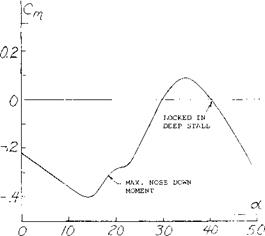DEEP STALL
The advent of the swept wing transport aircraft with aft “T-TAILS” and aft mounted nacelles has led to a number of fatalities that stem from the aircraft entering a region known as “deep stall”. The first major accident from deep stall occurred during a test flight of a twin engine swept wing T-TAIL airplane while determining its stall characteristics.
Basic Cause. The basic cause of deep stall is the unstable pitching moment generated by the wing when operating at high lift coefficients, (18). This moment tends to drive the airplane to high angles of attack unless corrective action is undertaken. Since swept wing aircraft stall at very high angles of attack, it is possible for the airplane to be at a very high angle. In this condition the separated flow from the wing and nacelles, (18,a), blanket the horizontal tail with low energy air making it an ineffective control, as illustrated on figure 36. The separated wing flow reduces the maximum available nose-down pitching moment, figure 37, so that once the airplane exceeds a angle of attack of 40° the airplane is locked in a deep stall condition. When in this condition the drag is very high, due to the separated flow, making it impossible to add enough thrust to fly the airplane out of this condition. Lateral controls are also ineffective due to stalling at the wing tips.
Deep Stall Prevention. Since an airplane can always enter a stall in the event of bad weather or other emergencies, the design must be changed to eliminate the problems discussed above.
There are several ways in which this can be accomplished and these have been discussed in previous sections of this chapter. Basically, the wing and wing flap systems must be designed to eliminate nacelles which leads to the use of T-TAILS, the strategic location of wing fences can be used with moderately swept wings, such as the early DC-9s. These fences induce a vortex over the horizontal tail which energizes the flow and maintains effective controls (18,f). Other methods of eliminating the blanketing of the horizontal tail is by the strategic location of the nacelles with respect to the fuselage.
Since the down wash produced by the center section of the wing can impinge on a high T-TAIL at the deep stall condition, some aircraft have been designed with a low horizontal tail of conventional types which remains effective at high angles of attack. Thus, effectiveness is obtained because the lower tail operates in air that is not affected by the wing wake. The low tail requires that the engines be placed elsewhere on the aircraft, which can also lead to other problems..
|
|
|
REFERENCE LINE HORIZON |
|
RELATIVE WIND |
FLIGHT PATH
LOW ENERGY WAKES OF WING AND NACELLES
|
|
|
Figure 37. Typical variation of pitching moment before and after deep stall condition. |
Mechanical Warning Devices. Since the stalling of swept wing aircraft can lead to extremely dangerous conditions, many mechanical devices have been investigated to warn the pilot of impending stall. These devices include both stick shakers and stick pushers. The stick shaker is arranged so that as stall is approaching the pilot is given warning by artificial shaking. With smaller aircraft, buffeting usually provides the necessary warning by shaking the stick, but with heavier aircraft with more advanced control systems, an artificial means is required. Another means of preventing the pilot from entering a stall is to effectively take the airplane out of his hands with a “stick pusher”. Such a device is used on several T-Tail swept wing transport aircraft as discussed in (18,e). There are, of course, many pros and cons with regard to the stick pusher configuration, but it has been selected as an effective safety device as the deep stall condition is such a disasterous maneuver.
Figure 36. Aircraft entering deep stall condition.
(18) Deep Stall:
a) Polhamus, Deep-Stall of T-Tail Aircraft Space and Aeronautics May 1966
b) Powers, Deep-Stall Pitch-Up T-Tail Aircraft NASA TN D-3370
c) Thomas, Longitudinal Behaviour Near-Stall AGARD Proc. No. 17
d) Taylor, Stability of T-Tail Transports, J. Aircraft July 1966
e) Davies, Deep Stalling, Flight International 18 March 1965
f) Shevell, Design Features of the DC-9, J. Aircraft. Nov. 1966.













